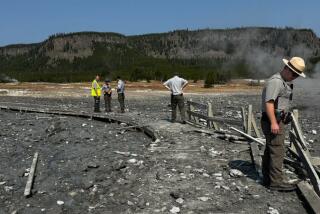Alaska’s Redoubt Volcano Erupts Again, Spews Ash : Nature: Pilots report ‘lightning and fireworks’ in area. Earthquake activity gave scientists an early warning sign.
- Share via
ANCHORAGE, Alaska — Redoubt Volcano began erupting again Tuesday evening, sending an ash plume as high as 45,000 feet into the air and presumably destroying a lava dome it had been building for several days.
“It’s erupting,” said Robert McGimsey of the Alaska Volcano Observatory. “It’s a big one.”
Monitoring equipment on the volcano and elsewhere indicated a strong eruption, said David Stone, a geophysicist with the volcano observatory.
A pilot reported seeing “lightning and fireworks” and a plume as high as 40,000 feet after the eruption occurred about 6 p.m., Stone said.
Several pilots reported lava was flowing down the northwest flank of the mountain 115 miles southwest of Anchorage, McGimsey said.
He added it was possible the flow was actually a mixture of ash and hot gas rather than lava. He said scientists would have to wait until daylight to investigate.
The volcano spewed an “extensive ash plume,” and it appeared the ash generally remained in the area of Redoubt, McGimsey said. Light winds blowing toward Anchorage were expected to shift slightly to the south overnight, the National Weather Service said.
“Normally, these things go on for some time, a matter of hours or a day,” Stone said.
The Federal Aviation Administration advised pilots to “continually evaluate operations to and from Anchorage.” At least one plane, a Delta Airlines flight scheduled from Seattle to Anchorage, turned back after the pilot announced that the plume was headed for Anchorage.
Officials were concerned about flash flooding on the Drift River but were unable to determine whether flooding was occurring. The eruption started after the sun had set, preventing scientists from getting a look at the mountain.
Employees of the Drift River oil facility near the volcano were evacuated earlier Tuesday in anticipation of an eruption, said McGimsey, who had predicted an eruption within 24 hours of Tuesday morning because of stepped-up seismic activity.
McGimsey said the mountain, 110 miles southwest of Anchorage, began erupting at 5:50 p.m. after several hours of markedly increased earthquake activity.
In the last several days, the volcano had been building a lava dome that by Tuesday had grown to several thousand square feet and descended down the mountain’s north flank.
McGimsey said Tuesday’s eruption was apparently stronger than those in mid-December, when the volcano emerged from a 25-year sleep.
Scientists have been monitoring the volcano around the clock. After resting for a quarter of a century, the peak erupted on Dec. 13 and spewed ash 33,000 feet into the air the next day. Varying levels of seismic activity continued through the month.
During last month’s eruption, Christmas travelers and mail were delayed and Anchorage air traffic slowed to a trickle after a KLM Royal Dutch Airlines Boeing 747 flew through ash, lost power to all four engines and fell more than two miles. The plane made a safe emergency landing after the engines were restarted.
McGimsey said there was an increase in shallow earthquakes in the volcano dome. More temblors occurred seven to 10 kilometers beneath the 10,197-foot peak 115 miles southwest of Anchorage, he said.
“And there were a couple of energetic pulses yesterday evening and early this morning,” McGimsey said. Those were strong enough to have been felt on seismic instruments at Mount Spurr, some 80 miles to the northeast.
More to Read
Sign up for Essential California
The most important California stories and recommendations in your inbox every morning.
You may occasionally receive promotional content from the Los Angeles Times.













